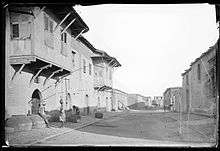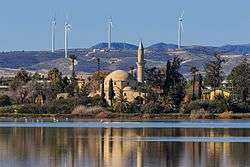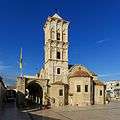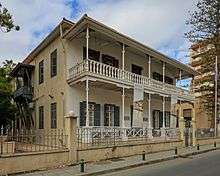Larnaca
| Larnaca | ||||||
|---|---|---|---|---|---|---|
From top left to right: Athinon Avenue, the fort, salt lake and the Hala Sultan Tekke, the Church of Saint Lazarus | ||||||
| ||||||
 Larnaca Location in Cyprus | ||||||
| Coordinates: 34°55′N 33°38′E / 34.917°N 33.633°ECoordinates: 34°55′N 33°38′E / 34.917°N 33.633°E | ||||||
| Country |
| |||||
| District | Larnaca District | |||||
| Government | ||||||
| • Type | Municipal council | |||||
| • Mayor | Andreas Vyras (AKEL) | |||||
| Elevation | 85 ft (26 m) | |||||
| Population (2011)[1] | ||||||
| • City | 51,468 | |||||
| • Urban | 84,591 | |||||
| The urban population is the aggregate of the populations of Larnaca, Aradippou, Livadia, Dromolaxia and Meneou. | ||||||
| Time zone | EET (UTC+2) | |||||
| • Summer (DST) | EEST (UTC+3) | |||||
| Area code(s) | +357 24 | |||||
| Website |
www | |||||
Larnaca (Greek: Λάρνακα [ˈlarnaka]; Turkish: Larnaka or İskele) is a city on the southern coast of Cyprus and the capital of the eponymous district. It is the third-largest city in the country, after Nicosia and Limassol, with an urban population of 84,591 (2011).
Larnaca is known for its palm-tree seafront, the Church of Saint Lazarus, the Hala Sultan Tekke, the Kamares Aqueduct and its medieval fort. It is built on the ruins of ancient Citium, which was the birthplace of Stoic philosopher Zeno.
Larnaca is home to the country's primary airport, Larnaca International Airport. It also has a (both passenger and cargo) seaport and a marina.
Etymology
Larnaca might have taken its name from the many larnakes (sarcophagi) that are found in the area.[2] Sophocles Hadjisavvas, a state archeologist, states that "[the city's U.S.] consul of the last quarter of the 19th century, claimed to have explored more than 3,000 tombs in the area of Larnaca, so-called after the immense number of sarcophagi found in the modern town".[3]
History

_p046_BAZAAR_AT_LARNACA.jpg)
The former city-kingdom of Kition was originally established in the 13th century BC.[4] New cultural elements appearing between 1200 BC and 1000 BC (personal objects, pottery, new architectural forms and ideas) are interpreted as indications of significant political changes and the arrival of the Achaeans, the first Greek colonists of Kition.[5] Around the same time, Phoenicians settled the area.
At the archaeological sites of Kiteon, remains that date from the 13th century BC have been found. Around 1000 BC, Kition was rebuilt by Phoenicians and it subsequently became a center of Phoenician culture. The remains of the sites include cyclopean walls and a complex of five temples and a naval port.
It was conquered in the first millennium BC by a series of great powers of the region. First by the Assyrian Empire, then by Egypt. Like most Cypriot cities, Kition belonged to the Persian or Achaemenid Empire. In 450 BC, the Athenian general Cimon died at sea, while militarily supporting the revolt against Persia's rule over Cyprus. On his deathbed, he urged his officers to conceal his death from both their allies and the Persians.
Strong[6] earthquakes hit the city in 76 AD and the year after.
Earthquakes of 322 AD and 342 "caused the destruction not only of Kition but also of Salamis and Pafos".[6] Kition's harbor silted up, and the population moved to the seafront farther south, sometime after this. (Contributing factors to the silting are thought to have been earthquakes, deforestation and overgrazing.)
The commercial port was located at Skala, during the Ottoman Period. Skala is the name of the seashore immediately south of the Larnaca castle[7]—and its neighborhood. The city is sometimes colloquially referred to as "Skala" (Greek: Σκάλα) meaning "ladder" or "landing stage", referring to the historical port.
The Kamares aqueduct was built in 1747—bringing water to the city from a source around six miles (9.7 km) from the city.
Geography
The Salt Lake fills with water during the winter season and is visited by flocks of flamingoes who stay there from November until the end of March. It usually dries up in the summer. In the past, it yielded good quality salt scraped from the dried surface. The salt from the lake is now considered unsuitable for consumption.
Climate
The climate in this area is described by the Köppen Climate Classification System as a hot semi-arid climate due to its low annual rainfall and strong summer drought. It is sometimes described as a mediterranean climate, but its winter rainfall is below the required amount to avoid the semi-arid classification.
| Climate data for Larnaca | |||||||||||||
|---|---|---|---|---|---|---|---|---|---|---|---|---|---|
| Month | Jan | Feb | Mar | Apr | May | Jun | Jul | Aug | Sep | Oct | Nov | Dec | Year |
| Average high °C (°F) | 16.8 (62.2) |
16.8 (62.2) |
19.1 (66.4) |
22.5 (72.5) |
26.5 (79.7) |
30.3 (86.5) |
32.4 (90.3) |
32.7 (90.9) |
30.9 (87.6) |
28.1 (82.6) |
22.6 (72.7) |
18.3 (64.9) |
24.7 (76.5) |
| Daily mean °C (°F) | 12.1 (53.8) |
11.8 (53.2) |
13.9 (57) |
17.1 (62.8) |
21.2 (70.2) |
25.0 (77) |
27.3 (81.1) |
27.6 (81.7) |
25.4 (77.7) |
22.6 (72.7) |
17.5 (63.5) |
13.7 (56.7) |
19.6 (67.3) |
| Average low °C (°F) | 7.5 (45.5) |
6.9 (44.4) |
8.7 (47.7) |
11.7 (53.1) |
16.0 (60.8) |
19.8 (67.6) |
22.2 (72) |
22.6 (72.7) |
19.9 (67.8) |
17.1 (62.8) |
12.5 (54.5) |
9.2 (48.6) |
14.5 (58.1) |
| Average precipitation mm (inches) | 77.6 (3.055) |
40.9 (1.61) |
34.4 (1.354) |
17.7 (0.697) |
8.80 (0.3465) |
2.70 (0.1063) |
0.60 (0.0236) |
0.40 (0.0157) |
7.10 (0.2795) |
13.8 (0.543) |
53.1 (2.091) |
94.5 (3.72) |
351.5 (13.839) |
| Average precipitation days (≥ 1 mm) | 7.9 | 5.7 | 4.5 | 3.1 | 0.7 | 0.3 | 0.1 | 0.1 | 0.5 | 2.1 | 4.7 | 8.0 | 37.6 |
| Mean monthly sunshine hours | 195.3 | 208.8 | 238.7 | 267.0 | 331.7 | 378.0 | 387.5 | 365.8 | 312.0 | 275.9 | 216.0 | 179.8 | 3,356.5 |
| Source: Meteorological Service (Cyprus)[8] | |||||||||||||
Landmarks
The city's landmarks include: the Church of Saint Lazarus; the Catacomb of Phaneromeni Church; Hala Sultan Tekke; the Kamares Aqueduct; and the Fort of Larnaca.
So-called "Foinikoudes" is the promenade along Athenon Avenue on the seafront. A row of palm trees (Cypriot Greek: φοινικούδες foinikoudes) lines either side of it.
Monuments
- A bust of "Kimon the Athenian" stands on the Foinikoudes Promenade, with this quote referring to him on the pedestal: "Even in death he was victorious" (Greek: "Kαι νεκρός ενίκα").
- The marble bust of Zeno stands at the crossroads near the American Academy. Zeno was born in Kition in 334 BC. After studying philosophy in Athens, he founded the famous Stoic school of philosophy.
- The Armenian Genocide Memorial stands on Athinon Avenue.
Economy
Larnaca's economy has been growing since 1975, after the loss of the Port of Famagusta, which handled 80% of general cargo, and the closure of Nicosia International Airport, meant that Larnaca's airport and seaport had increasingly important roles in the economy of the island. A €650m upgrade of Larnaca Airport has been completed.
The service sector, including tourism, employs three-quarters of Larnaca's labor force. Many travel and tour operators and other travel-related companies have their head offices in Larnaca.
Education
There are over a hundred educational institutions in the city, including the American Academy, Larnaca Nareg Armenian school and the Alexander College.
Culture
Arts
Larnaca has a theatre and an art gallery, which are operated by the municipality. The Cornaro Institute was a cultural centre founded by the celebrated Cypriot artist Stass Paraskos in the Old Town in 2007, which staged contemporary art exhibitions and other cultural events, prior to its closure by Larnaca Municipality in 2017.
Music
Local institutions include the Municipal Wind Orchestra.
Sports
Local teams include (football:) AEK Larnaca FC and ALKI Larnaca FC. Due to the Turkish occupation of Famagusta, the two teams of Famagusta, Anorthosis and Nea Salamina, are located here.
Local sports arenas include GSZ Stadium, "Antonis Papadopoulos", and "Ammochostos".
International competitions held in the city, include the Shooting Shotgun European Championships in 2012, the FIVB Beach Volleyball SWATCH Youth World Championship in 2012, the European Under-19 Football Championship final in 1998 and the European Under-17 Football Championship final in 1992.
Larnaca attracts windsurfers from around the world especially in autumn. Mackenzie Beach hosts windsurfing centre together with an extreme sports centre.
Festivals
Much of the activity is centered on the city promenade during the major festivals. The most important of these is Kataklysmos or the Festival of the Flood, celebrated in early summer with a series of cultural events. The festival used to last for about a week, but, in recent years, with the increased commercialism of peripheral stalls, rides and temporary lokmades restaurants, the festival has been extended to about three weeks, during which the seafront is closed to traffic in the evenings. Lokmades (or loukoumades) is a sweet delicacy.
Museums
Museums found in Larnaca include the Larnaca District Archaeological Museum, Pierides Museum and Kyriazis Medical Museum.
Cuisine
The beaches of Larnaca are lined with nearly identical seafood restaurants catering to tourists. Although there are many continental and international restaurants in Larnaca, visitors do not miss out on indulging in the local food. Many of the staple dishes involve beans, such as fasolaki (French beans cooked in red wine with lamb), and louvi me lahana (black-eyed beans with chard). Some of the standard appetizers are potato salad, kohlrabi salad, and hot grilled black olives. The next course may include Cyprus village sausage and sheftalia, dolmades and keftedes, kolokassi in tomato sauce, and several aubergine-based dishes. Baked or grilled lamb (souvla) usually appears somewhere in the course of dining, as does some kind of fish.
Neighborhoods
Larnaca's neighborhoods include Skala, Prodromos, Faneromeni, Drosia, Kamares, Vergina and Agioi Anargyroi.
Nightlife
Club DEEP first opened on October 1, 2010, is a Large club situated in the Heart of Larnaca's Hot Party Spot, providing you with the edgy sounds of RnB, Hip Hop, Bashment & House. It hosts some of the best parties each week and even hosted some of the best DJs in Cyprus.
Transport
The city's transport hubs are Larnaca International Airport and Larnaca Port—the Republic's busiest airport and second busiest port, respectively.
Public transport
Public transport in Larnaca is served only by buses. Bus routes and timetables can be found here.
International relations
Twin towns – sister cities
Larnaca Municipality is twinned with the following:[9]
-
 Acapulco, Mexico (since 2011)[10]
Acapulco, Mexico (since 2011)[10] -
 Ajaccio, France (since 1989)
Ajaccio, France (since 1989) -
 Bratislava, Slovakia (since 1989)[11]
Bratislava, Slovakia (since 1989)[11] -
 Galaxidi, Greece (since 2005)[12]
Galaxidi, Greece (since 2005)[12] -
 Giannitsa, Greece (since 2003)[12]
Giannitsa, Greece (since 2003)[12] -
 Glyfada, Greece (since 1998)
Glyfada, Greece (since 1998) -
 Ilioupoli, Greece (since 2000)[12]
Ilioupoli, Greece (since 2000)[12] -
 Larissa, Greece (since 1990)[12]
Larissa, Greece (since 1990)[12] -
 Leros, Greece (since 2000)[12]
Leros, Greece (since 2000)[12] -
 Haringey, United Kingdom (since 1987)
Haringey, United Kingdom (since 1987) -
 Marrickville, Australia (since 2005)
Marrickville, Australia (since 2005) -
 Novosibirsk, Russia (since 1993)
Novosibirsk, Russia (since 1993) -
 Odessa, Ukraine (since 2004)
Odessa, Ukraine (since 2004) -
 Piraeus, Greece (since 1999)[12]
Piraeus, Greece (since 1999)[12] -
 Poti, Georgia (since 1987)
Poti, Georgia (since 1987) -
 Sarandë, Albania (since 1994)
Sarandë, Albania (since 1994) -
 Szeged, Hungary (since 1993)
Szeged, Hungary (since 1993) -
 Tarpon Springs, Florida, United States (since 2009)
Tarpon Springs, Florida, United States (since 2009) -
 Tianjin, China (since 2007)
Tianjin, China (since 2007) -
 Tripoli, Lebanon
Tripoli, Lebanon -
 Tulcea, Romania (since 2003)
Tulcea, Romania (since 2003) -
 Venice, Italy (since 2010)
Venice, Italy (since 2010)
Notable residents
- Zeno of Citium (c. 334 – c. 262 BC), Stoic philosopher
- Apollonios of Kition (1st century BC), physician, nicknamed "the Cypriot Hippocrates"
- Ebubekir Pasha (1670 – 1757/1758), Governor of Larnaca and philanthropist
- Demetrios Pieridis (1811–1895), founder of the Pieridis Museum
- Dimitris Lipertis (1866–1937), national poet
- Neoclis Kyriazis (1877–1956), medical doctor and historian
- Mehmet Nazim Adil (1922–2014), leader of the Nakshbandi Sufi order (or Tekke), born in Larnaca
- Kyriacos A. Athanasiou, Cypriot-American academic, entrepreneur, and past-president of the Biomedical Engineering Society
- Stass Paraskos, artist
- Mihalis Violaris, singer and composer who helped popularise Cypriot music in Greece
- Giorgos Theofanous, composer
- Anna Vissi, singer
- Loucas Yiorkas, singer, The X Factor winner in 2009
- Ada Nicodemou, actress
- George Charalambous, actor
- Garo Yepremian, Armenian-Cypriot former NFL placekicker, played as a member of the 1972 Miami Dolphins, to date the only team in NFL history to finish with a perfect record
- Mark Davies, Caterham Supersport racer and fighter.
- Chrystalleni Trikomiti, Commonwealth Games gold-medalist rhythmic gymnast
Gallery
- Fishing port "Psarolimano"

 Castle exterior
Castle exterior- Castle square pier
- Kimon statue
 Finikoudes Avenue
Finikoudes Avenue- View of Larnaca from sea
 Larnaca marina
Larnaca marina- Larnaca Salt Lake
- Aspect of the old town
- Souvenir shops
- Old town
 Old aqueduct "Kamares"
Old aqueduct "Kamares"- Angeloktisti medieval church
- Street in town center
- Ermou square
 Saint Lazarus
Saint Lazarus- Vessels near Larnaca port
- Larnaca International Airport
 Larnaca Castle interior
Larnaca Castle interior Building of District Administration Larnaca
Building of District Administration Larnaca Europe square
Europe square
 Larnaca seafront panorama
Larnaca seafront panorama Panoramic view from Oroklini Hill towards Larnaca
Panoramic view from Oroklini Hill towards Larnaca The Armenian Genocide Memorial, unveiled in 2008
The Armenian Genocide Memorial, unveiled in 2008
See also
References
- ↑ "Population - Place of Residence, 2011". Statistical Service of Cyprus (CYSTAT). 17 April 2014.
- ↑ "The great number sarcophagoi (larnakes) found at Larnaca may have given to the modern city its name." Excerpt of wall mounted text at Larnaca District Museum, under the title "Kition: The necropolis"
- ↑ The Phoenician Period Necropolis of Kition, Volume I
- ↑ According to the text on the only plaque at the Kathari site (as of 2013).
- ↑ Excerpt of text on the only plaque at the Kathari site (as of 2013).
- 1 2 Flourentzos, P. (1996). A Guide to the Larnaca District Museum. Ministry of Communications and Works – Department of Antiquities. p. 18. ISBN 978-9963-36-425-1.
- ↑ Road & Tourist Map of Larnaka. SELAS LTD. ISBN 978-9963-566-92-1.
- ↑ "Meteorological Service – Climatological and Meteorological Reports".
- ↑ Οι αδελφοποιήσεις της Λάρνακας. Larnaca Municipality (in Greek). Retrieved 14 April 2014.
- ↑ "Se llevan a cabo gestiones para realizar hermanamiento entre Lárnaca y Acapulco" (PDF) (in Spanish). Retrieved 2 February 2017.
- ↑ "Partner (Twin) towns of Bratislava". Bratislava-City.sk. Archived from the original on 28 July 2013. Retrieved 5 August 2013.
- 1 2 3 4 5 6 "Αδελφοποιήσεις – Twinnings" (PDF). Central Union of Municipalities & Communities of Greece. Retrieved 14 April 2014.
External links
| Wikimedia Commons has media related to Larnaca. |
- Municipality
- Larnaka Municipal Wind Orchestra
 Larnaca travel guide from Wikivoyage
Larnaca travel guide from Wikivoyage



.jpg)
